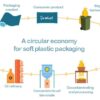The Essential Role of Compostable Packaging in Waste Management
Over the past five years, compostable packaging has gained traction, yet there remains significant confusion about its purpose. The main goal isn’t just recyclability; instead, compostable packaging aims to divert food waste from incineration, converting it into valuable compost while preventing food contamination in recycling processes.
Compostable materials are primarily focused on three areas: fruit labels, tea bags, and foodservice packaging. Contrary to popular belief, compostables don’t necessarily contaminate recycling streams, reducing recycling rates. In fact, due to food contamination, recycling rates in these specific applications are already low. To truly enhance recycling rates, it’s vital to use materials that can integrate with food waste, ensuring it doesn’t become a contaminant. The real function of compostables is to allow food, liquids, and food-stained items to be disposed of in one bin, leaving recycling streams clean and dry. This approach not only fosters a valuable organic waste industry but also boosts recycling rates across various waste streams, including organic waste, paper, glass, and metal.
It’s essential to understand that manufacturers of compostable foodservice packaging don’t propose replacing all plastics with compostables. Established recycling systems already exist for items like PET bottles and HDPE milk cartons. Compostables are specifically created to address areas where recycling is unfeasible due to contamination by organic materials.
Presently, nearly all foodservice packaging ends up being incinerated. We grow food crops, extract oil to produce plastics, cut down trees for packaging, and then burn everything. This unsustainable cycle of resource extraction contributes to increased CO2 emissions and soil degradation. By adopting compostable materials, we can eliminate the need for oil extraction for packaging, establishing a closed-loop system where food waste and packaging are transformed into nutrient-rich compost.
Many foodservice businesses are keen to make environmentally responsible choices and are willing to pay extra for products made from recycled and recyclable materials. However, these materials often end up being incinerated due to food contamination. While it’s encouraging to see the growth of the Post-Consumer Recycled materials market and initiatives like Extended Producer Responsibility, we must question the effectiveness of the system if these materials are ultimately burned upon re-entering the foodservice industry.









